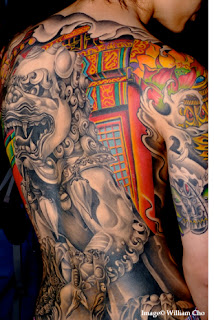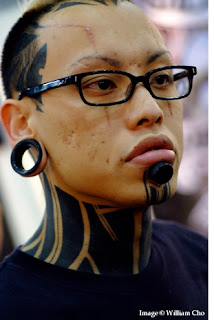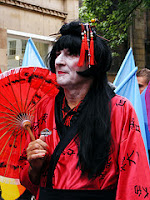Body art and modification has been practised for thousands of years across the globe. People have cut, stretched, dyed and pierced their bodies for recognition, relationships, beauty and rites of passage.
The RAI is launching an international photo competition that seeks to find out more about body modification by exploring questions such as:
- Who is involved in body art and modification communities?
- Why do people permanently alter their bodies?
- What are the symbols, meanings, and relationships attached to body alterations?
- Where do practitioners, artists, doctors congregate?
-What type of tourism has this diverse industry created?
THE BODY CANVAS
The Body Canvas photography contest forms part of the RAI’s Discover Anthropology Outreach Programme http://www.discoveranthropology.org.uk
The contest aims to:
• promote public engagement with the RAI’s Education Outreach Programme
• provide a platform for people to share their work and become actively involved in anthropology
• develop an understanding for the personal, social and political reasons why people undergo permanent body modification
• explore the many ways in which communities around the world develop and express relationships with their bodies
• explore the industry of body modification, the artists, doctors and craftsmen who practise their trade
The submissions we are looking for:
Engaging photographs that explore biological, cross-cultural and social elements of body art and modification in relation to these categories:1) Tattoos and Scarification
2) Piercings and Body Reshaping
Below are themes that could be visualised under each category. They are meant to be illustrative and not restrictive. Applicants are encouraged to think creatively about how they can communicate these categories and relate their photographs to anthropological themes. Photographs can include aspects related to body modification such as media and advertising, rituals, material objects, technological advancements, forensics.
- the commercialisation and commodification of body art and modification
- the growing industry of tattoos (parlours, conventions, festivals, TV programmes, films)
- the relationship between tattoos/scarification and metamorphosis (self-development, discovery and growth as an individual)
- tattooing as a discipline where well-known professionals are respected for their craftsmanship
- the community of body modification artists and cross-pollination of ideas and practises
- tourism generated by the artists/trade and practitioners
- body modification as a means of expressing one’s spiritual/religious beliefs
- body modification and controversy, social exclusion or stigma
- body modification as a means of expressing group identity and reaffirming social ties and status
- tattooing as an addiction- adrenaline, pleasure, thrill and excitement
- body modification and exhibitionism
- body modification and rites of passage
- tattoos and forensic anthropology
- cultural interpretations of beauty and aesthetics
- tattoos and art
- tattoos carrying protective elements against disease, illness, evil spirits and possession
Category 2: Piercings and Body Reshaping
- pushing the body to its physical extremes, dealing with fear, emotion and pain
- body reshaping and perceptions of strength, beauty, and attractiveness
- body building, fitness and popular culture
- plastic surgery and perceptions of beauty, age and social status
- reconstructing the body after accidents, illness,
- body reshaping and the media
- body modification as a means of expressing group identity and reaffirming social ties and status
Who can participate:
The competition is free to enter and is open to anyone within the UK and abroad who is interested in anthropology, photography and the body. Both professional and amateur photographers are welcome.
Guidelines for submissions:
• All applicants must fill in the registration form which can be found on the following website: www.discoveranthropology.org.uk
**Participants must complete a separate form for each of their submissions**
• To be considered for the photo competition, each photograph must be accompanied by a title and text of 50-150 words to be included in the registration form.
• Participants can submit a maximum of four photographs to EACH of the categories: 1) Tattoos and Scarification 2) Piercings and Body Reshaping . Composite images can be entered as well
• Photographers may not submit the same image to more than one category
• Once a photograph has been submitted, it is final and may not be replaced by another photograph.
• Photographs need to be submitted in high resolution JPEG/ TIFF or PNG format and sized less than 10MB. Please send submissions to Nafisa Fera, the RAI Education and Communications Officer at education@therai.org.uk
• Submissions must be suitable for all audiences. We will not accept R-Rated photographs including adult themes, sexually-oriented nudity or genitalia.
• Submissions that infringe copyright agreements, are unethical or disrespectful of anyone will disqualify the photographer from the contest.
• The RAI is not responsible for any late, misrouted, lost or damaged entries
• All decisions made by the judges are final
• The prize is non-exchangeable
How will the submissions be judged?
The Royal Anthropological Institute has appointed a panel of judges who will assess the photos based on the following criteria:
- creativity and originality of the photograph
- quality of the written text and its incorporation and exploration of anthropological themes
- technical quality of the photograph
To get some ideas of other RAI photo contests take a look at our Flickr webpage: www.flickr.com/photos/raieducation
Deadlines for submission
The deadline for submissions is 30th September 2012
The RAI will notify the applicants of the panel's decision by November 2012.
Prizes
All short-listed contestants will be published in RAI educational materials. In addition, the winning photograph from each category will receive a £100 Amazon gift voucher.
Copyright and Data Protection
All images submitted for consideration to the RAI’s Body Canvas Photo Competition remain the sole property of the photographer. By submitting to the contest the entrants agree that the RAI has the right to use and display their work for the RAI’s online and printed materials or for further use (as the RAI deems appropriate) without requiring additional compensation. The RAI will cite entrants as copyright holders of their work in its own publications, but takes no responsibility for any third party usage of photographs.
Any personal data acquired will be used primarily in connection with the RAI’s Body Canvas Photo Contest to facilitate communication with the entrant and for consideration of future RAI activities, competitions and events. The data will not be passed on to third parties without the prior consent of the entrant.
For further enquiries
Please contact the Royal Anthropological Institute’s Education & Communications Officer Nafisa Fera at education@therai.org.uk or 020 7387 0455 with any further enquiries.
Sources of Information and Inspiration
For more information about body art and modification take a look at these great online resources:
Pitt Rivers Museum Body Arts website
Penn Museum of Anthropology and Archaeology Body Cultures website


















+copy.jpg)


























